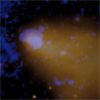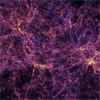CXC Home | Search | Help | Image Use Policy | Latest Images | Privacy | Accessibility | Glossary | Q&A
Tour of Abell 3376
Quicktime MPEG
This composite image of the galaxy cluster Abell 3376 shows X-ray data from the Chandra X-ray Observatory and the ROSAT telescope along with an optical image from the Digitized Sky Survey and radio emission observed by the Very Large Array. The "bullet-like" appearance of the X-ray data is caused by a merger, as material flows into the galaxy cluster from the right side. Two different teams used Chandra observations of galaxy clusters, including Abell 3376, to study the properties of gravity on cosmic scales. This allowed them to test the Theory of General Relativity, and it turns out Einstein and his theory are still holding their own. Such studies are crucial for understanding the evolution of the universe, both in the past and the future, and for probing the nature of dark energy, one of the biggest mysteries in science.
[Runtime: 01:03]
Quicktime MPEG
This composite image of the galaxy cluster Abell 3376 shows X-ray data from the Chandra X-ray Observatory and the ROSAT telescope along with an optical image from the Digitized Sky Survey and radio emission observed by the Very Large Array. The "bullet-like" appearance of the X-ray data is caused by a merger, as material flows into the galaxy cluster from the right side. Two different teams used Chandra observations of galaxy clusters, including Abell 3376, to study the properties of gravity on cosmic scales. This allowed them to test the Theory of General Relativity, and it turns out Einstein and his theory are still holding their own. Such studies are crucial for understanding the evolution of the universe, both in the past and the future, and for probing the nature of dark energy, one of the biggest mysteries in science.
[Runtime: 01:03]
(Credits: X-ray (NASA/CXC/SAO/A. Vikhlinin; ROSAT), Optical (DSS), Radio (NSF/NRAO/VLA/IUCAA/J.Bagchi)
Simulation of Growth of Structures
Quicktime MPEG
The simulation shows how the universe has evolved from soon after the Big Bang to the present day. As the universe expanded and cooled, matter began to clump together due to the effects of gravity, and large structures such as galaxies and clusters of galaxies formed, over billions of years. This growth has been suppressed by dark energy over the last 5 billion years, as the expansion of the universe accelerates. Chandra observations of the growth of galaxy clusters over time, and of the weight distribution of galaxy clusters in the nearby universe, have been used to test Einstein's theory of General Relativity and test an alternative theory of gravity on cosmic scales.
[Runtime: 01:27]
Quicktime MPEG
The simulation shows how the universe has evolved from soon after the Big Bang to the present day. As the universe expanded and cooled, matter began to clump together due to the effects of gravity, and large structures such as galaxies and clusters of galaxies formed, over billions of years. This growth has been suppressed by dark energy over the last 5 billion years, as the expansion of the universe accelerates. Chandra observations of the growth of galaxy clusters over time, and of the weight distribution of galaxy clusters in the nearby universe, have been used to test Einstein's theory of General Relativity and test an alternative theory of gravity on cosmic scales.
[Runtime: 01:27]
(Credits: MPE/V.Springel)
Return to Abell 3376 (April 14, 2010)




